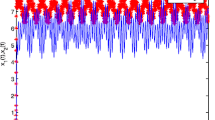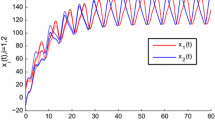Abstract
This paper studies the multiperiodicity and exponential attractivity evoked by periodic external inputs in cellular neural networks with discrete delays and distributed delays. We show that an n-neuron cellular neural network with mixed delays can have \(2^n\) periodic orbits located in saturation regions and these periodic orbits are locally exponentially attractive. Besides, some conditions for ascertaining periodic orbits to be locally exponentially attractive and allowing them to locate in any designated region are derived. The simulation results show that the proposed results are effective.


Similar content being viewed by others
References
J.D. Cao, G. Feng, Y.Y. Wang, Multistability and multiperiodicity of delayed Cohen–Grossberg neural networks with a general class of activation functions. Phys. D 237, 1734–1749 (2008)
W.H. Chen, J.C. Zhong, Z.Y. Jiang, X.M. Lu, Periodically intermittent stabilization of delayed neural networks based on piecewise Lyapunov functions/functionals. Circuits Syst. Signal Process. 33(12), 3757–3782 (2014)
F. Ding, X.M. Liu, Y. Gu, An auxiliary model based least squares algorithm for a dual-rate state space system with time-delay using the data filtering. J. Franklin Inst. 353(2), 398–408 (2016)
F. Ding, X.M. Liu, M.M. Liu, The recursive least squares identification algorithm for a class of Wiener nonlinear systems. J. Franklin Inst. 353(7), 1518–1526 (2016)
F. Ding, X.M. Liu, X.Y. Ma, Kalman state filtering based least squares iterative parameter estimation for observer canonical state space systems using decomposition. J. Comput. Appl. Math. 301, 135–143 (2016)
F. Ding, L. Xu, Q.M. Zhu, Performance analysis of the generalized projection identification for time-varying systems. IET Control Theory Appl. (2017). doi:10.1049/iet-cta.2016.0202
L. Feng, M.H. Wu, Q.X. Li et al., Array factor forming for image reconstruction of one-dimensional nonuniform aperture synthesis radiometers. IEEE Geosci. Remote Sens. Lett. 13(2), 237–241 (2016)
D.W. Gong, F.L. Lewis, L.P. Wang, K. Xu, Synchronization for an array of neural networks with hybrid coupling by a novel pinning control strategy. Neural Netw. 77, 41–50 (2016)
Y. He, M.D. Ji, C.K. Zhang, M. Wu, Global exponential stability of neural networks with time-varying delay based on free-matrix-based integral inequality. Neural Netw. 77, 80–86 (2016)
Z.K. Huang, S. Mohamod, H.H. Bin, Multiperiodicity analysis and numerical simulation of discrete-time transiently chaotic non-autonomous neural networks with time-varying delays. Commun. Nonlinear Sci. Numer. Simul. 15, 1348–1357 (2010)
Y.J. Huang, H.G. Zhang, Z.S. Wang, Multistability and multiperiodicity of delayed bidirectional associative memory neural networks with discontinuous activation functions. Appl. Math. Comput. 219, 899–910 (2012)
Y. Ji, X.M. Liu, Unified synchronization criteria for hybrid switching-impulsive dynamical networks. Circuits Syst. Signal Process. 34(5), 1499–1517 (2015)
Y. Ji, X.M. Liu, F. Ding, New criteria for the robust impulsive synchronization of uncertain chaotic delayed nonlinear systems. Nonlinear Dyn. 79(1), 1–9 (2015)
H.F. Li, H.J. Jiang, C. Hu, Existence and global exponential stability of periodic solution of memristor-based BAM neural networks with time-varying delays. Neural Netw. 75, 97–109 (2016)
H. Li, Y. Shi, W. Yan, On neighbor information utilization in distributed receding horizon control for consensus-seeking. IEEE Trans. Cybern. (2016). doi:10.1109/TCYB.2015.2459719
H. Li, Y. Shi, W. Yan, Distributed receding horizon control of constrained nonlinear vehicle formations with guaranteed \(\gamma \)-gain stability. Automatica 68, 148–154 (2016)
B.W. Liu, Global exponential convergence of non-autonomous cellular neural networks with multi-proportional delays. Neurocomputing 191(26), 352–355 (2016)
Y.W. Mao, F. Ding, A novel parameter separation based identification algorithm for Hammerstein systems. Appl. Math. Lett. 60, 21–27 (2016)
X.B. Nie, Z.K. Huang, Multistability and multiperiodicity of high-order competitive neural networks with a general class of activation functions. Neurocomputing 82, 1–13 (2012)
J. Pan, X. Jiang, X.K. Wang, W.F. Ding, A filtering based multi-innovation extended stochastic gradient algorithm for multivariable control systems. Int. J. Control Autom. Syst. (2017). doi:10.1007/s12555-016-0081-z
J. Pan, X.H. Yang, H.F. Cai, B.X. Mu, Image noise smoothing using a modified Kalman filter. Neurocomputing 173, 1625–1629 (2016)
M.V. Thuan, L.V. Hien, V.N. Phat, Exponential stabilization of non-autonomous delayed neural networks via Riccati equations. Appl. Math. Comput. 246(1), 533–545 (2014)
X.K. Wan, Y. Li, C. Xia, M.H. Wu, J. Liang, N. Wang, A T-wave alternans assessment method based on least squares curve fitting technique. Measurement 86, 93–100 (2016)
D.Q. Wang, Hierarchical parameter estimation for a class of MIMO Hammerstein systems based on the reframed models. Appl. Math. Lett. 57, 13–19 (2016)
C. Wang, R.P. Agarwal, Almost periodic dynamics for impulsive delay neural networks of a general type on almost periodic time scales. Commun. Nonlinear Sci. Numer. Simul. 36, 238–251 (2016)
D.Q. Wang, F. Ding, Parameter estimation algorithms for multivariable Hammerstein CARMA systems. Inf. Sci. 355–356(10), 237–248 (2016)
Y.J. Wang, F. Ding, Recursive least squares algorithm and gradient algorithm for Hammerstein–Wiener systems using the data filtering. Nonlinear Dyn. 84(2), 1045–1053 (2016)
Y.J. Wang, F. Ding, Novel data filtering based parameter identification for multiple-input multiple-output systems using the auxiliary model. Automatica 71, 308–313 (2016)
Y.J. Wang, F. Ding, The filtering based iterative identification for multivariable systems. IET Control Theory Appl. 10(8), 894–902 (2016)
D.Y. Wang, L.S. Li, Mean-square stability analysis of discrete-time stochastic Markov jump recurrent neural networks with mixed delays. Neurocomputing 189(12), 171–178 (2016)
T.Z. Wang, J. Qi, H. Xu et al., Fault diagnosis method based on FFT-RPCA-SVM for cascaded-multilevel inverter. ISA Trans. 60, 156–163 (2016)
T.Z. Wang, H. Wu, M.Q. Ni et al., An adaptive confidence limit for periodic non-steady conditions fault detection. Mech. Syst. Signal Process. 72–73, 328–345 (2016)
J.L. Wang, H.N. Wu, T.W. Huang, Passivity-based synchronization of a class of complex dynamical networks with time-varying delay. Automatica 56, 105–112 (2015)
J.L. Wang, H.N. Wu, T.W. Huang, S.Y. Ren, Pinning control strategies for synchronization of linearly coupled neural networks with reaction-diffusion terms. IEEE Trans. Neural Netw. Learn. Syst. 27(4), 749–761 (2016)
J.L. Wang, H.N. Wu, T.W. Huang, S.Y. Ren, J. Wu, Pinning control for synchronization of coupled reaction-diffusion neural networks with directed topologies. IEEE Trans. Syst. Man Cybern. Syst. 46(8), 1109–1119 (2016)
J.L. Wang, H.N. Wu, T.W. Huang, J.G. Wu, Passivity of directed and undirected complex dynamical networks with adaptive coupling weights. IEEE Trans. Neural Netw. Learn. Syst. (2016). doi:10.1109/TNNLS.2016.2558502
D.Q. Wang, W. Zhang, Improved least squares identification algorithm for multivariable Hammerstein systems. J. Franklin Inst. 352(11), 5292–5307 (2015)
L. Xu, A proportional differential control method for a time-delay system using the Taylor expansion approximation. Appl. Math. Comput. 236, 391–399 (2014)
L. Xu, Application of the Newton iteration algorithm to the parameter estimation for dynamical systems. J. Comput. Appl. Math. 288, 33–43 (2015)
L. Xu, The damping iterative parameter identification method for dynamical systems based on the sine signal measurement. Signal Process. 120, 660–667 (2016)
L. Xu, L. Chen, W.L. Xiong, Parameter estimation and controller design for dynamic systems from the step responses based on the Newton iteration. Nonlinear Dyn. 79(3), 2155–2163 (2015)
L. Xu, F. Ding, Recursive least squares and multi-innovation stochastic gradient parameter estimation methods for signal modeling. Circuits Syst. Signal Process. (2017). doi:10.1007/s00034-016-0378-4
Z. Zeng, J. Wang, Multiperiodicity and exponential attractivity evoked by periodic external inputs in delayed cellular neural networks. Neural Comput. 18, 848–870 (2006)
W. Zhang, C.D. Li, T.W. Huang, J.T. Qi, Global stability and synchronization of Markovian switching neural networks with stochastic perturbation and impulsive delay. Circuits Syst. Signal Process. 34(8), 2457–2474 (2015)
D. Zhang, L. Yu, Passivity analysis for discrete-time switched neural networks with various activation functions and mixed time delays. Nonlinear Dyn. 67(1), 403–411 (2012)
L.Q. Zhou, Y.Y. Zhang, Global exponential stability of a class of impulsive recurrent neural networks with proportional delays via fixed point theory. J. Franklin Inst. 353(2), 561–575 (2016)
Acknowledgments
This work was supported by the National Natural Science Foundation of China (Nos. 61472195, 61304093), the Taishan Scholar Project Fund of Shandong Province of China, the Natural Science Foundation of Shandong (ZR2012DL11), and the Applied Basic Research Project of Qingdao (14-2-4-116-jch)
Author information
Authors and Affiliations
Corresponding author
Rights and permissions
About this article
Cite this article
Ji, Y., Ding, F. Multiperiodicity and Exponential Attractivity of Neural Networks with Mixed Delays. Circuits Syst Signal Process 36, 2558–2573 (2017). https://doi.org/10.1007/s00034-016-0420-6
Received:
Revised:
Accepted:
Published:
Issue Date:
DOI: https://doi.org/10.1007/s00034-016-0420-6




